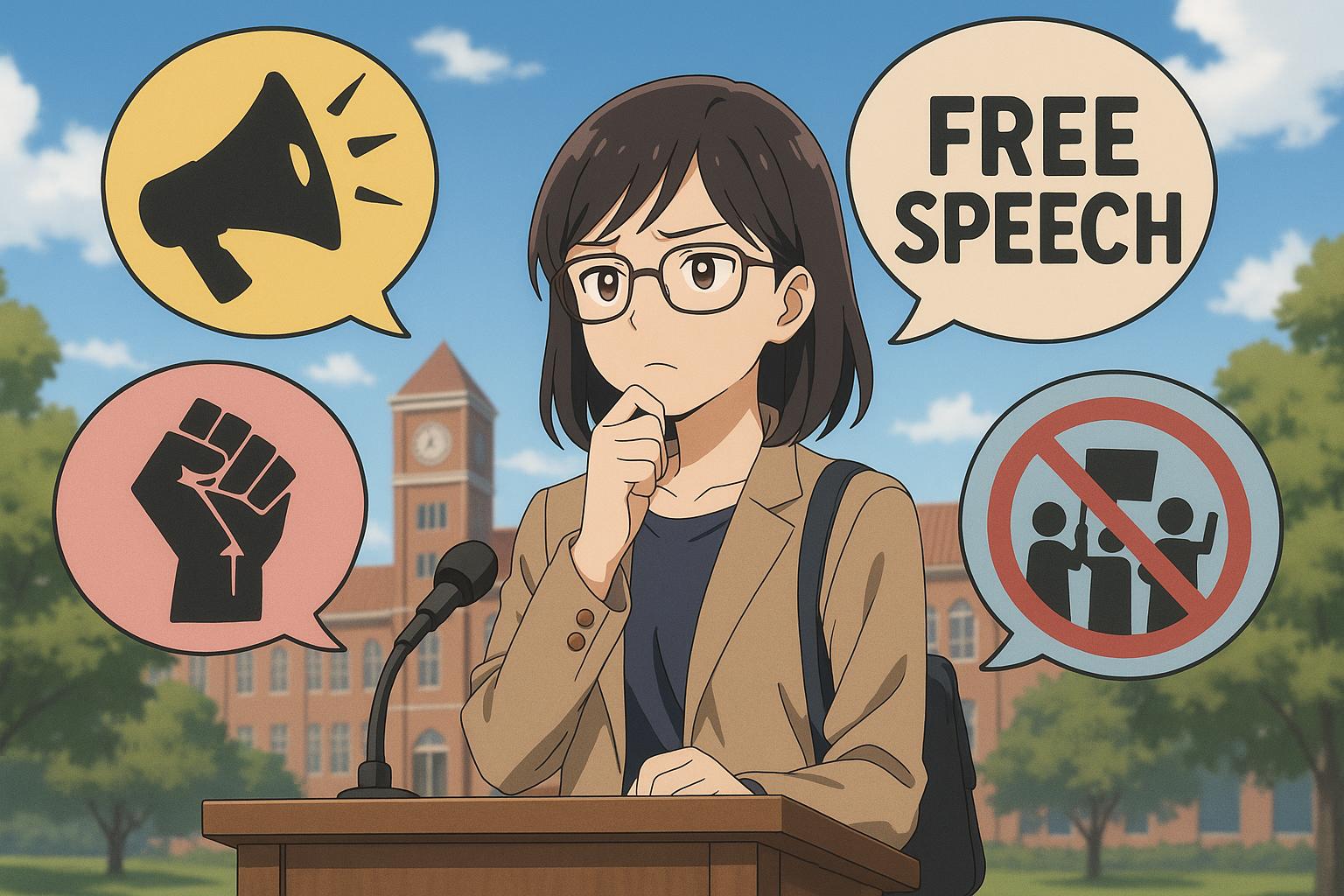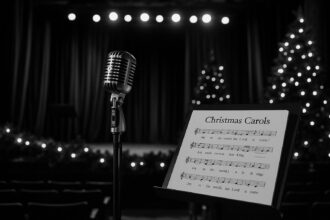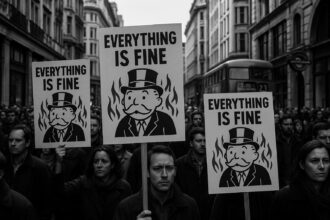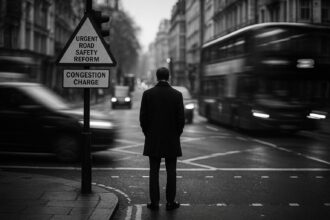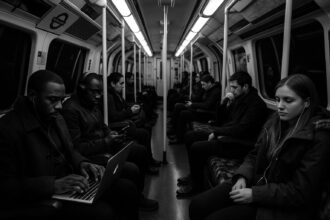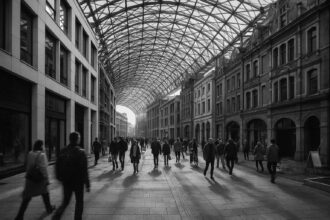As protests related to the Israel-Hamas conflict surge across US universities, debates intensify over free expression, institutional safety policies, and the limits of speech in academic spaces. With student confidence in free speech protections waning, colleges face mounting pressure to balance openness and security in a deeply divided climate.
The debate surrounding free speech on college campuses in the United States has intensified, particularly in light of recent events such as the Israel-Hamas war and the attendant protests. With academic institutions often positioned as bastions of diverse thought, the dialogue around invited speakers, protest policies, and institutional responses has erupted into what some are calling a “war over words.”
Recent protests against figures perceived as controversial, including white supremacists, have sparked discussions about the role of universities in fostering free expression while also ensuring student safety. University of Chicago President Robert Zimmer has voiced his support for an open discourse model, stating, “Discomfort is an intrinsic part of an education.” His stance reflects a broader concern among educators who believe that academic environments should not excessively shield students from ideas that may provoke discomfort or dissent.
This situation has been underscored by scrutiny faced by institutions such as Columbia University, which investigated students for their vocal support of pro-Palestinian activism. Critics have called into question the balance between free expression and institutional policy, particularly when such actions appear to suppress political dissent. The university faced backlash not only for its punitive measures but also in the wake of federal funding discussions linked to allegations of antisemitism. As tensions rise, this has led to a significant disquiet among student bodies regarding the reliability of their rights to free speech.
Moreover, the ramifications of recent geopolitical conflicts have introduced a chill effect on students’ willingness to engage in political discourse. At campuses like Indiana and Wesleyan, new protest policies are seen by some as attempts to protect vulnerable segments of the population, while detractors argue that these measures undermine the very principles of free expression. The tension has intensified discussions about how to protect students without infringing upon their rights to articulate dissenting views, resulting in a complex landscape for university leaders.
The current situation has reignited the debate over the concepts of safe spaces and trigger warnings, which some argue are necessary supports for students navigating difficult topics. However, others contend that such measures contribute to a culture of intellectual conformity and an aversion to challenging ideas—a phenomenon encapsulated in discussions about “microaggressions” and similar terminology. Critics argue that a focus on shielding students from discomfort could detract from developing resilience and critical thinking skills, essential qualities for navigating a diverse and often contentious world.
In an Axios event, educational and governmental leaders acknowledged that balancing free speech with safety concerns is increasingly fraught. Reports indicate that student confidence in the protection of their speech rights has declined significantly, reflecting broader societal anxieties. This decline illustrates a pressing need for universities to reevaluate their policies and approaches to upholding free expression amidst competing pressures.
Various voices in academia continue to advocate for robust dialogues surrounding free speech, positioning universities as forums for engaging with a spectrum of views. However, a significant faction counters that the term “free speech” is frequently co-opted to legitimise intolerant positions, complicating the conversation further. This ongoing tension presents formidable challenges as institutions navigate their roles in an ever-evolving landscape of political and social discourse.
Discussions about free speech on college campuses are unlikely to subside soon, especially as generational values shift and societal pressures evolve. As students increasingly demand both expressive freedom and protective measures, universities are compelled to seek a pathway that respects both principles, challenging them to foster environments conducive to both safety and open dialogue.
 Reference Map:
Reference Map:
Source: Noah Wire Services
- https://www.cbsnews.com/video/war-over-free-speech-on-campus/ – Please view link – unable to able to access data
- https://time.com/7265702/free-speech-on-campus-columbia-university/ – This article discusses the scrutiny Columbia University faced for investigating students critical of Israel, highlighting concerns over free speech and the suppression of political dissent. The university’s actions, including penalising students for pro-Palestinian activism, led to debates about the balance between free expression and institutional policies. The federal government’s withdrawal of funding due to perceived inaction on antisemitism further intensified the controversy. ([time.com](https://time.com/7265702/free-speech-on-campus-columbia-university/?utm_source=openai))
- https://apnews.com/article/46faa669edb6b8bf1da6f670f6186bbc – This article examines the impact of the Israel-Hamas war on free speech within U.S. college campuses, noting a chilling effect on students’ willingness to express their views due to fear of backlash. Universities like Indiana and Wesleyan have implemented restrictive protest policies, raising concerns about the balance between protecting students and upholding free speech. Efforts to foster civil discourse are ongoing, but challenges persist in maintaining open dialogue. ([apnews.com](https://apnews.com/article/46faa669edb6b8bf1da6f670f6186bbc?utm_source=openai))
- https://www.theatlantic.com/magazine/archive/2015/09/the-coddling-of-the-american-mind/399356/?utm_source=apple_news – This article explores the trend in American colleges where students seek protection from potentially discomforting ideas, leading to the rise of concepts like microaggressions and trigger warnings. It highlights instances where students requested to avoid certain topics and discusses the implications of this movement on intellectual and emotional development. The piece advocates for teaching resilience and critical thinking instead of shielding students from challenging ideas. ([theatlantic.com](https://www.theatlantic.com/magazine/archive/2015/09/the-coddling-of-the-american-mind/399356/?utm_source=openai))
- https://www.axios.com/2024/07/23/axios-event-college-free-speech-debate – This article reports on an Axios event where leaders from government and academia discussed the challenges universities face in balancing student free speech with safety concerns amid recent student protests, particularly related to the Israel-Hamas war. The event highlighted the complexities universities grapple with due to internal and external pressures, noting a significant drop in students’ confidence in the security of free speech. ([axios.com](https://www.axios.com/2024/07/23/axios-event-college-free-speech-debate?utm_source=openai))
- https://apnews.com/article/e3f891abf264f83de522f31b5c708b8e – This editorial criticises the University of Iowa for issuing ‘trespass warnings’ to protesters, arguing that such actions violate First Amendment rights and could deter free speech. It calls for university leaders to rescind the warnings and allow protests on campus, emphasising that the First Amendment should not be compromised. ([apnews.com](https://apnews.com/article/e3f891abf264f83de522f31b5c708b8e?utm_source=openai))
- https://time.com/4958261/eddie-glaude-special-snowflakes/ – This article addresses the debate on free speech on college campuses, countering the conservative claim that universities have become illiberal spaces that stifle diverse opinions. It argues that universities are vibrant spaces for free exchange of ideas, where students regularly engage with a range of political views, and critiques the use of ‘free speech’ arguments to protect intolerant and hateful views. ([time.com](https://time.com/4958261/eddie-glaude-special-snowflakes/?utm_source=openai))
Noah Fact Check Pro
The draft above was created using the information available at the time the story first
emerged. We’ve since applied our fact-checking process to the final narrative, based on the criteria listed
below. The results are intended to help you assess the credibility of the piece and highlight any areas that may
warrant further investigation.
Freshness check
Score:
8
Notes:
The narrative is current, with the CBS News report dated June 10, 2025. However, similar discussions have been ongoing since October 2023, particularly following the Israel-Hamas conflict, which intensified debates over free speech on college campuses. ([apnews.com](https://apnews.com/article/9cdda079a5649d080f5438c350a209f1?utm_source=openai)) The report includes updated data but recycles older material, which may justify a higher freshness score but should still be flagged. ([lemonde.fr](https://www.lemonde.fr/en/united-states/article/2024/04/14/academic-freedom-is-threatened-in-the-us_6668361_133.html?utm_source=openai))
Quotes check
Score:
7
Notes:
The report includes a direct quote from University of Chicago President Robert Zimmer: “Discomfort is an intrinsic part of an education.” This quote has been used in previous discussions on the topic, indicating potential reuse. ([apnews.com](https://apnews.com/article/9cdda079a5649d080f5438c350a209f1?utm_source=openai)) The wording matches earlier instances, suggesting the content may not be original.
Source reliability
Score:
9
Notes:
The narrative originates from CBS News, a reputable organisation known for its journalistic standards. This lends credibility to the report.
Plausability check
Score:
8
Notes:
The report discusses ongoing debates over free speech on college campuses, a topic that has been widely covered since October 2023. The inclusion of updated data strengthens its plausibility. However, the recycling of older material and the reuse of quotes suggest that some content may not be original. The tone and language are consistent with typical journalistic reporting, and the structure is coherent, indicating a plausible narrative.
Overall assessment
Verdict (FAIL, OPEN, PASS): OPEN
Confidence (LOW, MEDIUM, HIGH): MEDIUM
Summary:
The narrative is current and originates from a reputable source, lending it credibility. However, the recycling of older material and the reuse of quotes suggest that some content may not be original. The inclusion of updated data strengthens its plausibility, but the potential reuse of content warrants further scrutiny.


